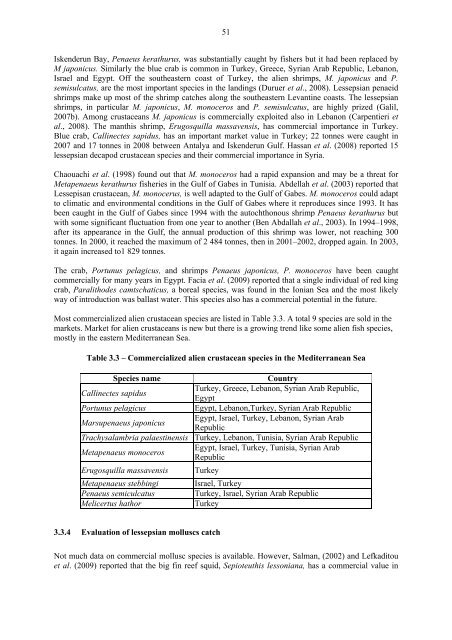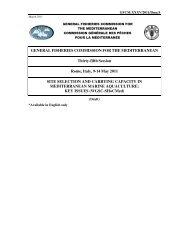Status of alien species in the Mediterranean and Black Sea
Status of alien species in the Mediterranean and Black Sea
Status of alien species in the Mediterranean and Black Sea
You also want an ePaper? Increase the reach of your titles
YUMPU automatically turns print PDFs into web optimized ePapers that Google loves.
51<br />
Iskenderun Bay, Penaeus kerathurus, was substantially caught by fishers but it had been replaced by<br />
M japonicus. Similarly <strong>the</strong> blue crab is common <strong>in</strong> Turkey, Greece, Syrian Arab Republic, Lebanon,<br />
Israel <strong>and</strong> Egypt. Off <strong>the</strong> sou<strong>the</strong>astern coast <strong>of</strong> Turkey, <strong>the</strong> <strong>alien</strong> shrimps, M. japonicus <strong>and</strong> P.<br />
semisulcatus, are <strong>the</strong> most important <strong>species</strong> <strong>in</strong> <strong>the</strong> l<strong>and</strong><strong>in</strong>gs (Duruer et al., 2008). Lessepsian penaeid<br />
shrimps make up most <strong>of</strong> <strong>the</strong> shrimp catches along <strong>the</strong> sou<strong>the</strong>astern Levant<strong>in</strong>e coasts. The lessepsian<br />
shrimps, <strong>in</strong> particular M. japonicus, M. monoceros <strong>and</strong> P. semisulcatus, are highly prized (Galil,<br />
2007b). Among crustaceans M. japonicus is commercially exploited also <strong>in</strong> Lebanon (Carpentieri et<br />
al., 2008). The manthis shrimp, Erugosquilla massavensis, has commercial importance <strong>in</strong> Turkey.<br />
Blue crab, Call<strong>in</strong>ectes sapidus, has an important market value <strong>in</strong> Turkey; 22 tonnes were caught <strong>in</strong><br />
2007 <strong>and</strong> 17 tonnes <strong>in</strong> 2008 between Antalya <strong>and</strong> Iskenderun Gulf. Hassan et al. (2008) reported 15<br />
lessepsian decapod crustacean <strong>species</strong> <strong>and</strong> <strong>the</strong>ir commercial importance <strong>in</strong> Syria.<br />
Chaouachi et al. (1998) found out that M. monoceros had a rapid expansion <strong>and</strong> may be a threat for<br />
Metapenaeus kerathurus fisheries <strong>in</strong> <strong>the</strong> Gulf <strong>of</strong> Gabes <strong>in</strong> Tunisia. Abdellah et al. (2003) reported that<br />
Lessepisan crustacean, M. monocerus, is well adapted to <strong>the</strong> Gulf <strong>of</strong> Gabes. M. monoceros could adapt<br />
to climatic <strong>and</strong> environmental conditions <strong>in</strong> <strong>the</strong> Gulf <strong>of</strong> Gabes where it reproduces s<strong>in</strong>ce 1993. It has<br />
been caught <strong>in</strong> <strong>the</strong> Gulf <strong>of</strong> Gabes s<strong>in</strong>ce 1994 with <strong>the</strong> autochthonous shrimp Penaeus kerathurus but<br />
with some significant fluctuation from one year to ano<strong>the</strong>r (Ben Abdallah et al., 2003). In 1994–1998,<br />
after its appearance <strong>in</strong> <strong>the</strong> Gulf, <strong>the</strong> annual production <strong>of</strong> this shrimp was lower, not reach<strong>in</strong>g 300<br />
tonnes. In 2000, it reached <strong>the</strong> maximum <strong>of</strong> 2 484 tonnes, <strong>the</strong>n <strong>in</strong> 2001–2002, dropped aga<strong>in</strong>. In 2003,<br />
it aga<strong>in</strong> <strong>in</strong>creased to1 829 tonnes.<br />
The crab, Portunus pelagicus, <strong>and</strong> shrimps Penaeus japonicus, P. monoceros have been caught<br />
commercially for many years <strong>in</strong> Egypt. Facia et al. (2009) reported that a s<strong>in</strong>gle <strong>in</strong>dividual <strong>of</strong> red k<strong>in</strong>g<br />
crab, Paralithodes camtschaticus, a boreal <strong>species</strong>, was found <strong>in</strong> <strong>the</strong> Ionian <strong>Sea</strong> <strong>and</strong> <strong>the</strong> most likely<br />
way <strong>of</strong> <strong>in</strong>troduction was ballast water. This <strong>species</strong> also has a commercial potential <strong>in</strong> <strong>the</strong> future.<br />
Most commercialized <strong>alien</strong> crustacean <strong>species</strong> are listed <strong>in</strong> Table 3.3. A total 9 <strong>species</strong> are sold <strong>in</strong> <strong>the</strong><br />
markets. Market for <strong>alien</strong> crustaceans is new but <strong>the</strong>re is a grow<strong>in</strong>g trend like some <strong>alien</strong> fish <strong>species</strong>,<br />
mostly <strong>in</strong> <strong>the</strong> eastern <strong>Mediterranean</strong> <strong>Sea</strong>.<br />
Table 3.3 – Commercialized <strong>alien</strong> crustacean <strong>species</strong> <strong>in</strong> <strong>the</strong> <strong>Mediterranean</strong> <strong>Sea</strong><br />
Species name Country<br />
Call<strong>in</strong>ectes sapidus<br />
Turkey, Greece, Lebanon, Syrian Arab Republic,<br />
Egypt<br />
Portunus pelagicus Egypt, Lebanon,Turkey, Syrian Arab Republic<br />
Marsupenaeus japonicus<br />
Egypt, Israel, Turkey, Lebanon, Syrian Arab<br />
Republic<br />
Trachysalambria palaest<strong>in</strong>ensis Turkey, Lebanon, Tunisia, Syrian Arab Republic<br />
Metapenaeus monoceros<br />
Egypt, Israel, Turkey, Tunisia, Syrian Arab<br />
Republic<br />
Erugosquilla massavensis Turkey<br />
Metapenaeus stebb<strong>in</strong>gi Israel, Turkey<br />
Penaeus semiculcatus Turkey, Israel, Syrian Arab Republic<br />
Melicertus hathor Turkey<br />
3.3.4 Evaluation <strong>of</strong> lessepsian molluscs catch<br />
Not much data on commercial mollusc <strong>species</strong> is available. However, Salman, (2002) <strong>and</strong> Lefkaditou<br />
et al. (2009) reported that <strong>the</strong> big f<strong>in</strong> reef squid, Sepioteuthis lessoniana, has a commercial value <strong>in</strong>
















